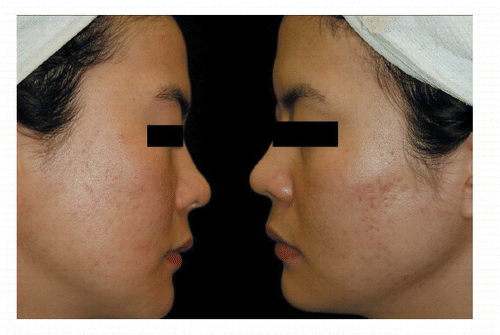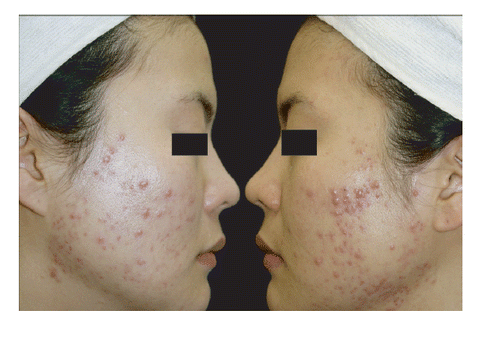Sirs,
A 30‐year‐old Korean female patient with Fitzpatrick type IV skin presented with inflammatory acne vulgaris and facial acne scars that had progressed for over 7 years. She had been treated with systemic and topical antibiotics, systemic isotretinoin, and multiple sessions of superficial chemical peeling using glycolic acid and salicylic acid at various private dermatology clinics. However satisfactory improvement could not be achieved with these treatments and pustular acne lesions continued to occur (). The patient did not have systemic isotretinoin treatment within recent six months.
After informed consent, three sessions of combined 595‐nm pulsed‐dye laser with dynamic cooling device (V beam™; Candela Corporation, Wayland, MA) and fractional photothermolysis system (FPS) therapy was performed at a 4‐week interval. The patient's face was cleansed with a mild skin cleanser followed by a topical application of EMLA cream (AstraZeneca AB, Södertälje, Sweden) for local anesthesia 1 hour prior to the procedure. The patient was prescribed oral acyclovir for 3 days as a prophylactic measure. Affected areas of the face were treated with non‐overlapping single pulses of the 595‐nm pulsed‐dye laser and two passes were delivered at 10 and 40 milliseconds pulse width, respectively. Treatment fluence was 11 J/cm2, using a 7 mm spot size. An integrated dynamic cooling device set at 20/20 milliseconds was used to cool the epidermis.
Afterwards, injections of 1% lidocaine mixed with 1:100,000 epinephrine were used for a supra‐ and infraorbital nerve block bilaterally. A 1,550‐nm wavelength FPS was performed using Sellas II™ laser (Dinona Corporation, Seoul, Korea). Five passes were undertaken. The first two passes were performed in moving‐operating mode with the setting of 12.5 mJ for the pulse energy and 169 pulses per area (PPA) for the spot density. The last three passes were performed in stamp‐operating mode with appropriate overlapping at the setting of 10 to 12.5 mJ for the pulse energy and 100 PPA for the spot density.
The patient was not prescribed with any isotretinoin or antibiotics between treatment intervals. The patient had presented subjective as well as objective clinical improvements of inflammatory acne lesions, enlarged facial pores, postinflammatory erythema, and acne scars, from the first session of the treatment. Although a few lesions were still noted after the treatments, acute flare‐up of the acne vulgaris was not observed. After 2 months from the last combined V beam™ and Sellas II™ laser treatment the patient was satisfied with the results () and complained of no major side‐effects.
Figure 2. Two months after three treatments with the combination of the 595‐nm pulsed‐dye laser and fractional photothermolysis system.

Four major factors have been proposed to contribute to the pathogenesis of acne, including: Citation1 excess sebum production, Citation2 follicular epithelial hyperproliferation and resultant follicular plugging, Citation3 presence of Propionibacterium (P.) acnes and the production of free fatty acids, and Citation4 follicular and perifollicular inflammation Citation1,Citation2. The currently available treatment modalities have been shown to affect these contributing factors.
The pulsed‐dye laser has been proved to be effective against inflammatory acne Citation1,Citation3,Citation4. It appears to kill P. acnes, which makes porphyrins. Moreover, energy from the laser is absorbed by oxyhemaglobin, which reduces vascularity and thereby decreases postinflammatory erythema and alters the inflammatory response of acne Citation1,Citation3,Citation4.
In addition to decrements in active acne lesions, our patient presented an improvement of acne scarring, which has already been proved to be effectively treated with FPS. FPS has demonstrated its effectiveness in the treatment of a wide variety of dermatologic diseases, including acne scars, hypopigmented scars, melasma, enlarged facial pores, and poikiloderma Citation5. FPS is able to directly affect the follicular epithelium of the pilosebaceous unit as well as new collagen production in the dermis Citation5. The authors believe that FPS could have influenced not only the acne scars and enlarged pores, but also the pathogenetic factors of the acne formation, especially on follicular epithelial hyperproliferation and follicular plugging.
In this report, two different modes of Sellas II™ laser, moving and stamp operating modes, were combined. We suggested that the multiple movement patterns of the moving‐operating mode enabled us to effectively treat large areas Citation5. Additionally, random spray shots on stamp and moving operating mode seemed to reduce the laser therapyassociated pain as well as thermal damages to surrounding tissues.
In conclusion, the combination therapy utilizing 595‐nm pulsed‐dye laser and FPS can be a safe, effective, and rapid treatment option for patients with both inflammatory acne vulgaris and acne scarring. However, further investigation regarding the synergistic effect of 595‐nm pulsed‐dye laser and FPS combination therapy and the selection of patients should follow.
References
- Harper JC. An update on the pathogenesis and management of acne vulgaris. J Am Acad Dermatol. 2004; 51: S36–8.
- Glaich ASFriedman PM, Jih MH, Goldberg LH. Treatment of inflammatory facial acne vulgaris with combination 595‐nm pulsed‐dye laser with dynamic‐cooling‐device and 1,450‐nm diode laser. Lasers Surg Med. 2006; 38: 177–80.
- Seaton ED, Charakida A, Mouser PE, Grace I, Clement RM, Chu AC. Pulsed‐dye laser treatment for inflammatory acne vulgaris: randomized controlled trial. Lancet. 2003; 362: 1347–52.
- Orringer JS, Kang S, Hamilton T, Schumacher W, Cho S, Hammerberg C, et al. Treatment of acne vulgaris with a pulsed dye laser a randomized controlled trial. JAMA. 2004; 291: 2834–9.
- Cho SB, Lee JH, Choi MJ, Lee KY, Oh SH. The efficacy of the fractional photothermolysis system with dynamic operating mode on acne scars and enlarged facial pores. Dermatol Surg. 2009; 35: 108–14.
